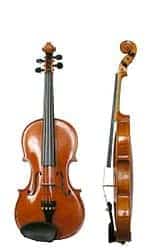After the recorder, the violin is the instrument most commonly offered to children by state schools in the UK.
The violin is a challenging instrument. Rapid, independent motion of the digital joints in the left hand is desirable. This study was conceived after an 11-year-old patient volunteered that she had given up playing the violin because of difficulty and discomfort manoeuvring the left small and ring fingers independently. On exami¬nation, she was found to have absent FDS (flexor digitorum superficialis) function in the small finger. The research investigated whether lack of inde-pendent movement of the small finger PIPJ affected the musical ability of string players. Because an ana¬tomical variation is fixed, training and strengthening exercises will be unlikely to correct any issues of technique that arise as a result.
 Professional string players were tested clinically, using standard and modified tests, for flexor digitorum superficialis function. Two additional physical tests were applied: the gap and stretch tests. The research confirms that elite violinists and viola players usually have independent FDS function. Based on the outcome of this study, a recommendation could be made for children to be examined being offered the violin or viola as an instrument. Not everyone needs to reach a professional level. If absent FDS function is confirmed, an explanation about why certain movements are difficult to execute might be more helpful than giving the advice to practise more.
Professional string players were tested clinically, using standard and modified tests, for flexor digitorum superficialis function. Two additional physical tests were applied: the gap and stretch tests. The research confirms that elite violinists and viola players usually have independent FDS function. Based on the outcome of this study, a recommendation could be made for children to be examined being offered the violin or viola as an instrument. Not everyone needs to reach a professional level. If absent FDS function is confirmed, an explanation about why certain movements are difficult to execute might be more helpful than giving the advice to practise more.
Abstract
This study estimated the prevalence of independent flexor digitorum superficialis function in the small fingers of 90 violin and viola players. The hypothesis tested was that the independent digital movements required in this population would select out those with absent flexor digitorum superficialis function. Professional string players were tested clinically, using standard and modified tests, for flexor digitorum superficialis function. Two additional physical tests were applied: the gap and stretch tests. These tests assess ring finger movement once the small finger is placed and the instrument is held in the chin-hold position. A statistically significant reduction in the prevalence of absent flexor digitorum superficialis function was confirmed in the musicians compared with a control group and published meta-analysis. This suggests that independent flexor digitorum superficialis function is important for professional musicians playing at an elite level.
If our reporting has informed or inspired you, please consider making a donation. Every contribution, no matter the size, empowers us to continue delivering accurate, engaging, and trustworthy science and medical news. Independent journalism requires time, effort, and resources—your support ensures we can keep uncovering the stories that matter most to you.
Join us in making knowledge accessible and impactful. Thank you for standing with us!
